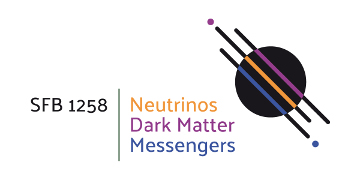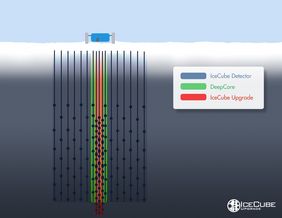The extension will expand the energy range of IceCube towards lower neutrino energies and bridge IceCube to smaller neutrino detectors worldwide. One of the two main goals is to study the oscillation properties of neutrinos, which can transform – or oscillate – from one type of neutrino to another as they travel through space. Understanding how neutrinos transform will help refine the Standard Model of particle physics.
Expanding the energy range of IceCube
The second focus is to better characterize the ice around IceCube sensors and thereby obtain better performance with the existing detector, thus yielding more precise reconstructions of neutrinos at all accessible energies. For this reason, 21 Precision Optical Calibration Modules (POCAMs) will be installed at a number of positions on the seven new strings to act as calibration light sources.
Reducing the uncertainties of the detector
“The POCAMs will allow us to significantly reduce the systematic uncertainties of the IceCube detector that are now at around 10 to 20 percent,” says Prof. Elisa Resconi, spokesperson of the SFB1258. Most notably, this will give high-energy neutrino astronomy a boost, as IceCube will be able to resolve the neutrino sky more sharply. Furthermore, understanding the ice better will enable the IceCube collaboration to improve the reconstruction of archived data collected over the past nine years.
POCAMs tested at Lake Baikal and the Pacific Ocean
A first prototype of the POCAM has been deployed within the emerging neutrino telescope in Lake Baikal in 2017 by students of Prof. Resconi. An updated version was then installed in the northern Pacific Ocean at depths of 2.6 Kilometers to probe the optical properties of the deep sea within the scope of Resconi’s STRAW project. “The two tests allowed us to gain very valuable experience with the operation that led to important improvements now used in IceCube”, says Felix Henningsen, PhD student of Elisa Resconi.
Optical modules with higher sensitivity
Together with the sensitivity enhanced optical modules, the POCAMs will be installed in the IceCube core in close proximity to previous strings at depths between of 1450 and 2450 Meters. This way, calibrations on old and new optical sensors can be performed. The new sensors will be two or three times more sensitive than the sensors that make up the current detector and will also be tested for a ten-times-larger extension of IceCube known as IceCube-Gen2.
Deployment in the polar field season 2022/23
Whereas the development of the POCAMs and part of the photo sensors was funded by the BMBF, Germany, the physical upgrade of IceCube, a 37 million US dollar extension, that will be enforced during the 2022/23 polar field season, has now secured 23 million US dollar through the National Science Foundation (NSF), USA. Last fall, activities got underway including setting up the IceCube Upgrade office thanks to initial funding from NSF and additional support from international partners in Japan and Germany as well as from Michigan State University and the University of Wisconsin–Madison.
The IceCube Neutrino Observatory is located at NSF’s Amundsen-Scott South Pole Station. Management and operation of the observatory is through the Wisconsin IceCube Particle Astrophysics Center at UW–Madison. The scientific program is run by the international IceCube Collaboration, with more than 300 scientists from 52 institutions spanning 12 countries. In Germany the DESY Zeuthen, the Karlsruhe Institute of Technology (KIT), the Universities of Berlin, Bochum, Erlangen-Nürnberg, Münster, Mainz and Wuppertal and the Technical Universities of Aachen, Dortmund and Munich are involved.
Further information:
<link https: icecube.wisc.edu news view external-link-new-window internen link im aktuellen>IceCube collaboration: NSF mid-scale award sets off the first extension of IceCube
Contact:
Prof. Elisa Resconi
Technical University of Munich
Physics Department/SFB1258
E-Mail: <link mail internen link im aktuellen>elisa.resconi@tum.de
Tel.: +49 89 289-12422



